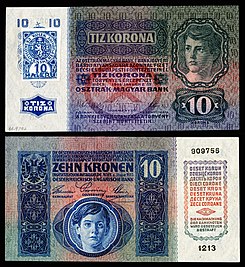Austro-Hungarian 10 Kčs banknote with 10 haléřů stamp | |
| ISO 4217 | |
|---|---|
| Code | CZK |
| Subunit | 0.01 |
| Unit | |
| Unit | Koruna |
| Symbol | Kč |
| Denominations | |
| Subunit | |
| 1⁄100 | Haléř |
| Symbol | |
| Haléř | h |
| Banknotes | |
| Freq. used | 10, 20, 50, 100, 500, 1000 korun |
| Demographics | |
| Date of introduction | 1919Provisional issue |
| User(s) | Czechoslovakia |
| Issuance | |
| Central bank | Czechoslovak National Bank |
| Valuation | |
| Inflation | Stable |
| This infobox shows the latest status before this currency was rendered obsolete. | |
The first banknotes in First Czechoslovak Republic were issues of the Austro-Hungarian Bank to which adhesive stamps were affixed. Denominations were of 10, 20, 50, 100 and 1000 korun (provisional issue). Regular banknotes of Czechoslovak koruna were subsequently issued (initially dated 15 April 1919) by the Republic of Czechoslovakia between 1919 and 1926, in denominations of 1, 5, 10, 20, 50, 100, 500, 1000 and 5000 korun. The Czechoslovak National Bank took over production in 1926, issuing notes for 10, 20, 50, 100, 500 and 1000 korun. The new designs were made by Alfons Mucha, one of the founders of Art Nouveau and a Slavic nationalist. The urgency of the task led him to reuse a previous portrait of Josephine Crane Bradley as Slavia for the 100 koruna bill.[1]
Provisional issue (1919)
[edit]| Value | Image | Date | Base date |
|---|---|---|---|
| 10 Korun | 1919 | 2 Jan 1915 | |
| 20 Korun | 1919 | 2 Jan 1913 | |
| 50 Korun | 1919 | 2 Jan 1914 | |
| 100 Korun | 1919 | 2 Jan 1912 | |
| 1,000 Korun | 1919 | 2 Jan 1902 |
See also
[edit]- Banknotes of the Czechoslovak koruna (1945)
- Banknotes of the Czechoslovak koruna (1953)
- Bohemian and Moravian koruna
References
[edit]- ^ An Introduction to the Work of Alphonse Mucha and Art Nouveau, lecture by Ian Johnston of Malaspina University-College, Nanaimo, BC. This document is in the public domain and may be used by anyone, in whole or in part, without permission and without charge, provided the source is acknowledged





